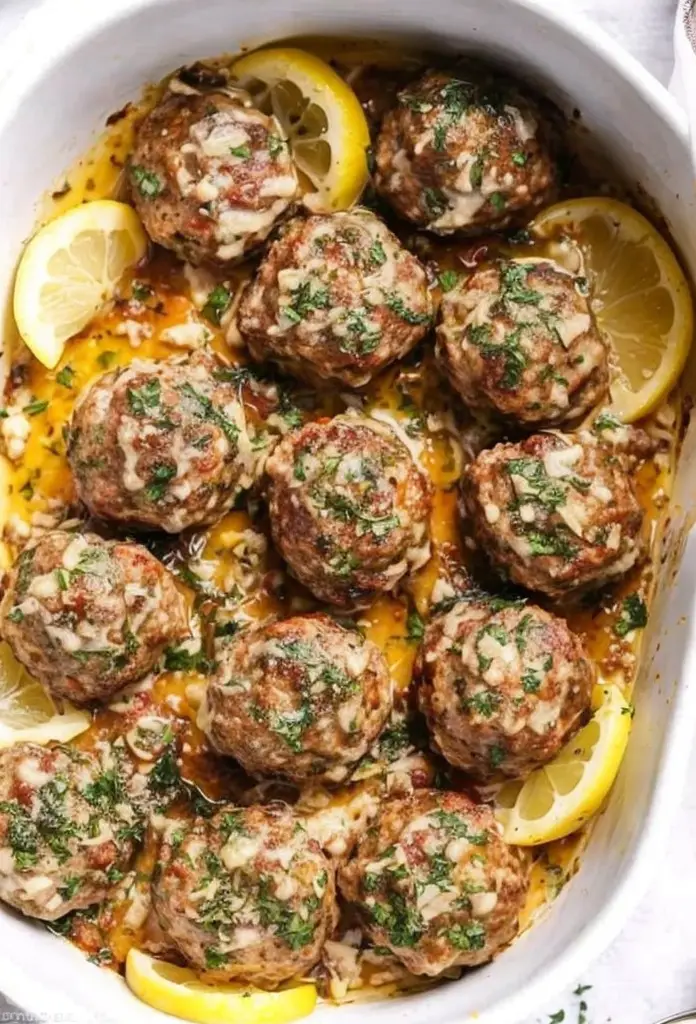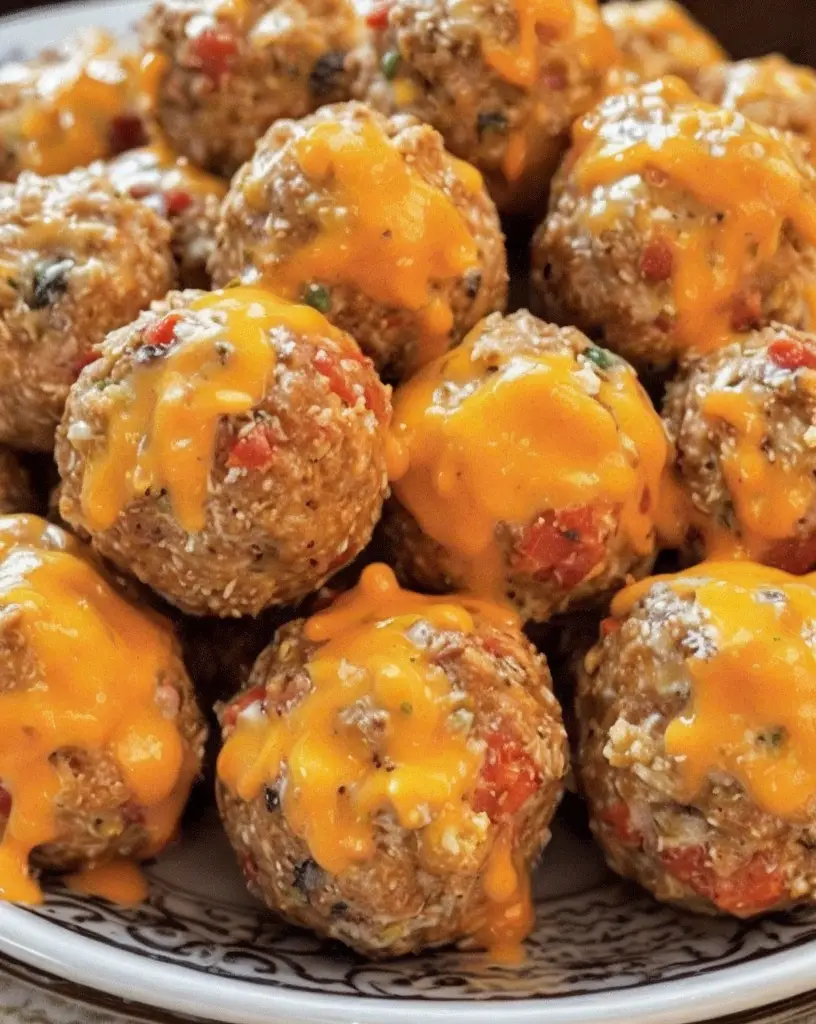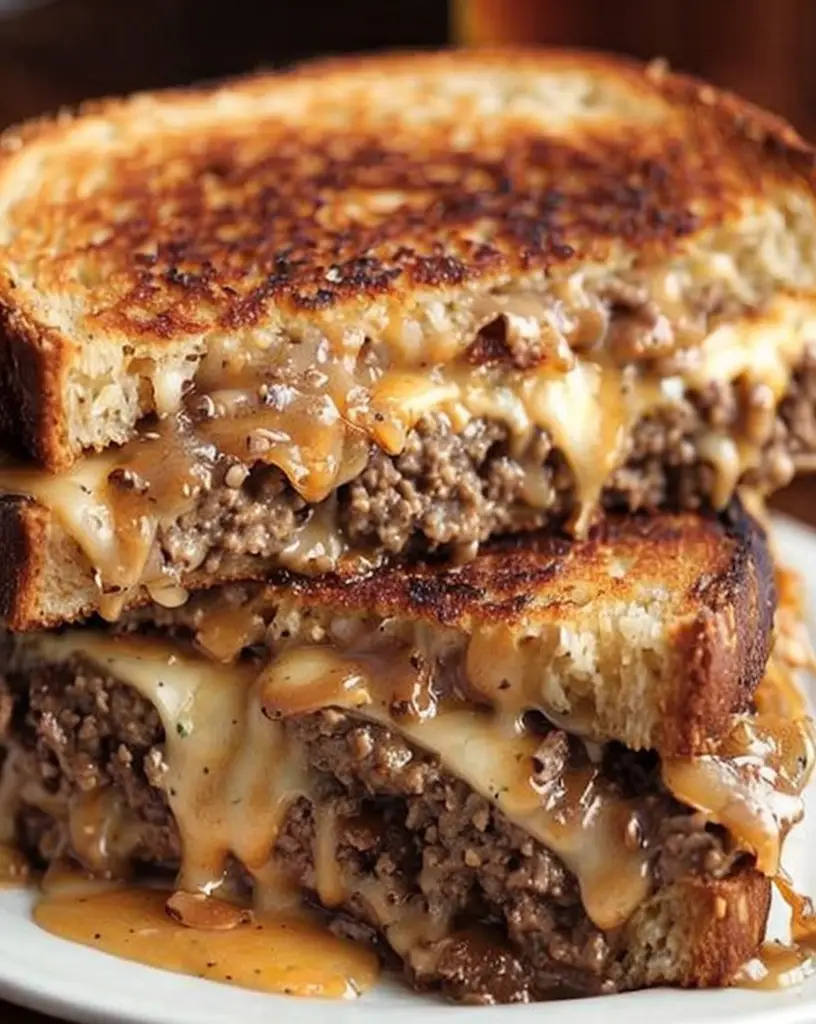Baked Turkey Meatballs with Lemon Garlic Butter Sauce: A Delicious and Healthy Meal
Satisfy your taste buds with these delicious and healthy baked turkey meatballs in lemon garlic butter sauce. Perfect for a weeknight dinner or a special occasion, this dish combines succulent turkey with an aromatic, tangy sauce that you won’t be able to resist. The fresh flavors of garlic and lemon blend seamlessly with the richness of butter to create a sauce that enhances the mild taste of the turkey meatballs perfectly.
Freshly baked turkey meatballs offer not only a healthier alternative to their beef counterpart but also bring a light and juicy texture to your meal. The tangy lemon garlic butter sauce is the hero of this recipe, infusing each bite with a burst of flavor that lingers on the palate. Whether served as a main course or appetizer, these meatballs are sure to impress your family and friends.
Quick Recipe Highlights
- Flavor Profile: The recipe offers a succulent blend of savory turkey meatballs with a bright and zesty lemon garlic butter sauce.
- Texture: These turkey meatballs are tender and juicy, enveloped in a smooth, velvety sauce.
- Aroma: The aromatic notes of garlic and lemon waft through the air, inviting anticipation with each step of the recipe.
- Visual Appeal: The golden-brown meatballs topped with a shimmering butter sauce make for an appetizing presentation.
- Skill Level Needed: This recipe is straightforward, requiring elementary cooking skills suitable for beginners.
- Special Equipment: No specialized equipment is needed beyond a baking tray and a mixing bowl.
Recipe Overview
- Difficulty Level: This recipe is designed for ease, involving basic cooking methods and straightforward steps to follow.
- Category: It falls under the comfort food category, perfect for dinner or an appetizer.
- Cuisine: With roots in various international kitchens, this recipe has a versatile culinary appeal, embodying flavors from Mediterranean cuisine.
- Cost: Budget-friendly, with primary ingredients like ground turkey and standard pantry items keeping costs low.
- Season: Ideal for all seasons but especially delightful in spring and summer due to the refreshing lemony undertones.
- Occasion: Suitable for family dinners, potlucks, or as appetizers for gatherings and celebrations.
Why You’ll Love This Recipe
Indulge in the taste and texture that make these baked turkey meatballs a household favorite. The tender consistency of ground turkey coupled with the creamy lemon garlic butter sauce delivers satisfaction in every bite. This dish’s taste appeal lies in the umami richness of the sauce offset by the bright notes of citrus, resulting in a balanced and delectable meal that keeps you coming back for more.
Convenience comes as a major advantage of this recipe. With a total time under an hour, this dish makes a quick and easy dinner option. The use of the oven eliminates the need for constant monitoring, allowing you to focus on other tasks while the meatballs bake to perfection.
Health-conscious individuals will appreciate the nutritional benefits. Ground turkey is a lean, protein-rich alternative to other meats, while the moderate use of butter finds balance through the addition of lemon juice, offering vitamin C and refreshing flavor.
Turkey meatballs in lemon garlic butter sauce lend themselves well to entertaining. They can be served in smaller portions for hors d’oeuvres or in larger quantities as a main meal, making them versatile for various social settings. Their visual appeal is enhanced by the bright, shiny glaze of the sauce, impressing guests well beyond just taste.
Cost-effectiveness and accessibility also play a role in why this recipe is a must-try. Using common ingredients found in most households, it keeps shopping minimal and expenses in check, while delivering a gourmet feel without the hefty price tag associated with dining out.
Historical Background and Cultural Significance
The turkey meatball’s origin story ties into the broader history of meatballs, which have found a place in many cultures worldwide. While Italian and Swedish meatballs often steal the spotlight, incorporating turkey into this classic dish is a nod to healthier, contemporary cooking trends.
Culturally, the use of turkey signifies a common choice in North America, especially in the United States, where it is a staple during festive occasions like Thanksgiving. This recipe showcases another way to enjoy the healthiness of turkey beyond traditional roasted preparations.
The evolution of the turkey meatball has been influenced by the increased focus on low-fat diets and the desire for flavorful, satisfying meals that don’t compromise nutritional goals. The addition of lemon garlic butter sauce adds a modern twist to traditional preparations by infusing it with Mediterranean flavors.
Regional variations have seen spices and herbs unique to different areas incorporated into the basic turkey meatball recipe. Whether it’s Italian herbs, Middle Eastern spices, or Asian soy sauce, these meatballs provide a canvas for combining global tastes with local favorites.
Ingredient Deep Dive
Ground turkey, the star ingredient, is leaner than most ground meats and is praised for its low fat content. Its history in American cuisine is rich, especially in substitutions for red meat. When selecting ground turkey, opt for fresh rather than frozen, and choose those with lower fat content for better flavor and cooking results. Store turkey in airtight packaging in the refrigerator and consume within two days or freeze directly if not used immediately. A great substitute for ground turkey can be ground chicken or lean beef, keeping texture and flavor close to the intended profile.
Lemon juice acts as a natural tenderizer and flavor enhancer, bringing brightness and acidity that cut through the richness of the butter. Lemons originated in Asia and have traveled well, becoming key ingredients in cuisines worldwide. When buying lemons, choose those that feel heavy for their size, indicating juiciness. Store them in the refrigerator crisper drawer for best preservation. Lime juice may substitute in a pinch, although it offers a slightly more aromatic sweetness.
Common Mistakes to Avoid
- Over-mixing the meatball blend can lead to dense meatballs, so combine ingredients until just mixed.
- Skipping the cooling phase for cooked turkey can create dry meatballs as juices are not retained.
- Using frozen turkey without allowing proper thawing time can lead to uneven cooking.
- Not properly seasoning the meat can result in bland meatballs, so ensure to add seasonings generously.
- Baking at incorrect temperatures can lead to undercooked or overcooked turkey meatballs. Keep an eye on them during cooking.
- Forgetting to taste and adjust the seasoning of the sauce can miss out on balanced flavors.
- Overcooking the meatballs leads to dryness; use a kitchen timer to maintain accurate cooking times.
- Adding the sauce too early can cause it to separate or become overly reduced; introduce it towards the end of cooking.
- Failing to whisk butter into the sauce properly may result in an oily rather than creamy consistency.
- Neglecting to rest the meatballs before serving can cause a spill of juices essential for optimal taste.
Essential Techniques
Mixing the meatball ingredients requires a light touch to maintain tender texture—a critical technique for success. Over-mixing can compact the proteins, making meatballs tough. Use your hands gently or a spatula until the ingredients just come together. Visual cues include a uniform mixture without visible streaks of egg or breadcrumbs, indicating readiness for forming meatballs.
Whisking the butter into the lemon garlic sauce is another crucial step. It emulsifies into a smooth finish, creating a glossy, rich sauce. Common pitfalls to avoid include adding butter in one go, which can split the sauce. Introduce it gradually, whisking continuously over low heat to prevent separation. A successful technique shows a thick and cohesive sauce without any oily separation on the surface.
Pro Tips for Perfect Baked Turkey Meatballs with Lemon Garlic Butter Sauce
1. Enhance flavors by marinating turkey in spices and herbs ahead of time, ensuring a deeply rooted taste in every bite.
2. Keep meatballs uniformly sized using a scoop to ensure even cooking and avoid underdone centers.
3. Add a pinch of sugar to balance citrus acidity and elevate the overall sauce profile.
4. Infuse the breadcrumb mixture with grated parmesan for an extra depth of umami.
5. For a subtle kick, incorporate red pepper flakes or cayenne into the sauce.
6. Use fresh herbs like basil or parsley to garnish, providing a vibrant pop of flavor and color.
Variations and Adaptations
These meatballs lend themselves beautifully to regional variations, with Italian-inspired versions utilizing oregano and basil, while a twist of cumin and coriander brings out Middle Eastern influences. Seasonal adaptations can be achieved by switching fresh herbs with dry ones for a warmer winter alternative. Dietary modifications are feasible with gluten-free breadcrumbs or a dairy-free sauce using olive oil in place of butter while maintaining most of the intended taste and texture. Scale the flavors by adding smoky paprika or zest from other citrus fruits like lime or orange for exciting variations, while texture can be modified with the addition of finely chopped vegetables such as zucchini to the meatball mixture for more moisture. Presentation alternatives include serving the meatballs over a bed of rice, in a sandwich, or paired with roasted vegetables for a complete meal.
Serving and Presentation Guide
For exceptional plating, place the meatballs neatly in a shallow dish, pooling the lemon garlic butter sauce around them to highlight the glossy glaze against the tender meat. Sprinkle fresh herbs like parsley or chives as a garnish, adding a splash of color and freshness. Traditional accompaniments include rustic bread for dipping, or a light arugula and Parmesan salad to offset the richness of the sauce. Modern serving suggestions encourage individual portions in bowls paired with zoodles or standout appetizers with toothpicks in each meatball for easy serving. Maintain the optimal serving temperature with warmed plates and portion appropriately to prevent overcrowding, preserving the dish’s elegant look and texture.
Wine and Beverage Pairing
Pairing baked turkey meatballs with wine elevates the dining experience. A crisp Sauvignon Blanc or a light Pinot Grigio complements the lemony sauce, while a medium-bodied red like Pinot Noir provides enough depth without overwhelming the dish. Non-alcoholic alternatives include herbal iced tea or a lemon-infused sparkling water to keep flavors aligned. Keep beverages chilled and serve in appropriate glassware to enhance the overall visual and sensory experience. An unsweetened aromatic coffee can balance richness, providing a lingering palate cleanse to pair seamlessly with this flavorful dish.
Storage and Shelf Life
To store leftovers or prep in advance, place the cooled meatballs in an airtight glass or BPA-free plastic container, separating layers with parchment paper to avoid sticking. Refrigerate within two hours of cooking to maintain freshness for up to three days. For freezing, place the meatballs on a baking sheet to freeze individually before transferring to airtight bags, keeping them for up to two months. Check for spoilage through changes in appearance or smell before reheating. Reheat gently in the oven at 180°C (350°F) to preserve moisture without drying, and avoid using a microwave to prevent rubbery textures.
Make Ahead Strategies
Maximize convenience by preparing elements of this recipe in advance. Prepare turkey meatballs a day ahead and store uncooked in the refrigerator or fully bake them prior, cooling before refrigerating. The lemon garlic butter sauce can also be made early; just reheat gently while whisking before serving. Store each component separately, combining them fresh during meal assembly for ultimate texture and taste. When reheating, careful monitoring preserves quality, while finishing with freshly squeezed lemon and herbs ensures vibrant flavor and appearance.
Scaling Instructions
Scaling this recipe for larger gatherings is simple. Doubling or tripling the ingredients naturally adjusts cooking times slightly, necessitating the use of multiple baking trays or consecutive batches. Ensure adequate spacing if baking simultaneously to avoid steaming. Equipment adjustments may include larger mixing bowls or replacement of smaller utensils with those fit for larger quantities. Storage needs increase, so clear refrigerator space for cooked meatballs and sauces. Timing modifications involve staggered entries into the oven to manage doneness accurately. Halving the recipe similarly decreases effort, maintaining all ratios perfectly for an intimate dining occasion while keeping consistent quality and taste.
Nutritional Deep Dive
This recipe offers a macro breakdown with high protein content from turkey and moderate fats from butter, while restrictive in carbohydrate intake, aligning well with low-carb diets. Micronutrients like vitamin C from lemons and essential minerals found in garlic add to its healthful profile. Its portion analysis supports weight management by providing hearty servings that satisfy hunger without excessive calorie intake. Health benefits extend with lean proteins promoting muscle maintenance and metabolic function, supported by essential amino acids from turkey. Dietary considerations encourage mindful consumption, with a focus on balanced meal components and controlled portion sizes.
Dietary Adaptations
For gluten-free needs, replace regular breadcrumbs with a GF-certified variety or almond meal. Dairy-free swaps involve substituting butter with olive or avocado oil in the sauce, optimizing flavor. A vegan adaptation calls for a plant-based protein option, such as lentil or chickpea mixtures, paired with vegetable broth for the sauce base. Low-carb goals align with minimizing breadcrumb quantities, emphasizing turkey’s natural content. For keto dieters, maintain healthy fat levels with increased butter use while omitting any sugar. Paleo adherents thrive from using clean-seasoned turkey, whole food ingredients, and fresh herbs. Low-FODMAP adjustments can include lactose-free butter and avoiding garlic or onion powder replacements, keeping the focus on gut-friendly meal renderings. Adaptations foster inclusivity and centered eating, adhering to numerous dietary needs seamlessly and deliciously.
Troubleshooting Guide
Address texture issues by evaluating meat mixtures before cooking; overly dense meatballs can originate from over-mixing, requiring adjustments in handling. Flavor balance might necessitate more seasonings, with tasting key to identifying missing elements. Temperature problems should involve checking oven accuracy, using an oven thermometer to enhance control. Equipment challenges include maintaining sharp knives and non-stick baking surfaces for ease of preparation and cooking. Ingredient substitutions should adapt by leveraging similar textures and tastes, such as light meats or veggie bases. Timing concerns refer to ensuring meatballs are adequately, yet not overly, baked, testing via thermometer for internal temperature. Addressing these areas ensures successful outcomes every time, maintaining delicious results consistently.
Recipe Success Stories
Enthusiastic community feedback has highlighted the universal appreciation of this recipe’s flavors and ease of preparation. Variations like adding Parmesan or using chicken have led to successful reinterpretations, expanding its culinary landscape. Reader suggestions involve garnishing with toasted breadcrumbs for added texture, or incorporating zest blends for intricate depths. Culinary photography tips list creating structured shots by showcasing vibrant garnishes creatively. This dish’s adaptability forms the gateway to culinary exploration, allowing personal touches and inspiration from community experiences to shape its journey further.
Frequently Asked Questions
- Can I substitute turkey with chicken? Absolutely! Ground chicken offers a similar, slightly superior moisture retention when cooked.
- How do I prevent meatball dryness? Avoid over-cooking and rest for five minutes to reabsorb juices before serving.
- What makes the sauce separate? Ensure butter is whisked gradually and consistently to emulsify well with other liquids.
- Are gluten-free breadcrumbs recommended? Yes, GF breadcrumbs are excellent; almond meal is an alternative for added crustiness.
- How long do leftovers last? Refrigerated leftovers stay fresh for up to three days post preparation.
- Can lemon be substituted with lime? Lime provides a unique but suitable twist, altering the profile slightly.
- Is there a vegetarian alternative? Swap turkey with lentils or chickpea formulations for non-meat adaptations.
- Where can I find quality turkey? Source via trusted butchers or reputable grocery chains, ensuring premium purchase value.
- Will using unsalted butter change results? Skip extra salt if using salted butter, but adjust taste accordingly.
- What’s the best serving size? Cater to main course portions or appetizer offerings, ideal for any social occasion.
Additional Resources
Discover additional recipes complementing this meal, such as side dishes like garlic parmesan mashed potatoes or vibrant green salads balancing hearty meatball brightness. Access technique guides illustrating effective meatball forming and sauce whisking, creating digital learning portals. Expand ingredient understanding with informational pieces on turkey’s nutrition, lemon’s benefits, and butter’s emulsification properties, aiding recipe mastery. Equipment recommendations facilitate ease of preparation—invest in quality tools facilitating better bite enjoyment through attentive kitchen management. Seasonal variations drive creativity year-round, inspired project directions branching from this foundational recipe. Rich details ignite culinary drafts, evolving traditional foundations into boldly spectacular presentations.
Join the Conversation
Engage by sharing personalized outcomes of baked turkey meatballs on social media, tagging thematic content experiences. Offer internet advice capturing completed recipe beauty through creative photography—provide angles incorporating each dish’s allure. Submit detailed reviews reflecting journey and immersion in the recipe, inducing community curiosity. Enable further adaptations driven by reader comments encouraging change acceptance. Capture the heart of baking experiences and connection opportunities by navigating recipe enhancements collaboratively. Smile in each savory success participant nuance celebrated through digital bonds.
The Recipe
Baked Turkey Meatballs with Lemon Garlic Butter Sauce
Serves: 4
Prep Time: 15 mins
Cook Time: 25 mins
Total Time: 40 mins
Kitchen Equipment Needed
- Baking tray
- Mixing bowl
- Oven
- Saucepan
- Whisk
- Measuring cups and spoons
Ingredients
- 1 lb ground turkey
- 1 egg
- ½ cup breadcrumbs
- 2 cloves garlic, minced
- 1 tablespoon fresh parsley, chopped
- 1 teaspoon salt
- ½ teaspoon black pepper
- 2 tablespoons butter
- Juice of 1 lemon
- ¼ cup chicken broth
Directions
- Preheat oven to 400°F (200°C). Line a baking tray with parchment paper.
- Combine ground turkey, egg, breadcrumbs, garlic, parsley, salt, and pepper in a mixing bowl.
- Shape the mixture into small meatballs and place on the prepared tray.
- Bake in the oven for 20-25 minutes, or until cooked through.
- While meatballs are baking, melt butter in a saucepan over medium heat. Add lemon juice and chicken broth, whisking until combined.
- Simmer for several minutes until slightly thickened. Set aside.
- Remove meatballs from oven and drizzle with lemon garlic butter sauce before serving.
Recipe Notes
- For an extra herbaceous touch, add more fresh parsley to garnish.
- Adjust lemon juice to taste for a less or more intense citrus flavor.
- Substitute ground chicken if preferred.




